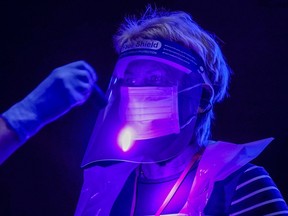An illusion using the magic of substances that fluoresce when exposed to ultraviolet light won Joe Switzer a prize at the 1934 Pacific Coast Association of Magicians Convention.

The dancer reached up with her arms and to the amazement of the audience lifted her head off her body. As the head stayed put, the headless body continued to prance across the stage. This illusion won Joe Switzer a prize at the 1934 Pacific Coast Association of Magicians Convention. It was some scientific magic that made this illusion possible: the magic of substances that fluoresce when exposed to ultraviolet light.
Back in 1671, Isaac Newton had conducted his famous experiment of passing sunlight through a prism and noting that it was separated into the colours of the rainbow. Then in 1800, William Herschel used a thermometer to measure the temperature in each of the resulting colours and found that there was a sequential increase, with the highest temperature seen at the red edge. Much to his surprise, when he moved the thermometer below the red colour, there was a dramatic increase in temperature despite no coloured light shining on the thermometer bulb. He had discovered an invisible form of radiation that came to be known as “infrared” from the Latin “infra” for below.
This intrigued Johann Wilhelm Ritter, who had been apprenticed to an apothecary in Germany at the age of 14 and had developed a keen interest in chemistry that led to him becoming a self-taught scientist of note. Ritter wondered if there were also some invisible rays beyond the other end of the visible spectrum, that is, past the violet colour. He had been carrying out some experiments with paper soaked in a solution of silver chloride that at the time was known to darken when exposed to sunlight, a phenomenon that later would lead to the invention of photography. When in 1801 Ritter held the silver chloride paper just beyond the violet end of the spectrum, the paper turned dark very quickly. He had discovered yet another type of invisible ray that would be named “ultraviolet” from the Latin “ultra,” for “beyond.”
It took another 100 years before ultraviolet light would be produced in a fashion allowing for further studies. That was thanks to American physicist Robert Williams Wood, who discovered that glass containing compounds of barium, sodium and nickel was able to block visible light while allowing ultraviolet rays to pass through. By this time, Edison’s incandescent light bulbs had made a triumphant entry into the marketplace and Wood produced what could be called the first “black light” by surrounding the glowing filament with his “Wood’s glass.” Various substances, ranging from butterfly wings to minerals such as fluorspar (calcium fluoride), glowed when exposed to black light. Such substances were said to be “fluorescent,” a term that had been coined in 1852 by Irish scientist Sir George Stokes for materials that convert invisible ultraviolet light into longer visible wavelengths.
Fluorescence would later be explained by ultraviolet light causing some electrons in the substance to be shifted to a higher energy level and this energy being released as the electrons return to their former energy level. Some of this energy is released as heat and the rest as visible light. This means that a fluorescent substance in addition to reflecting visible light also produces some extra visible light, meaning that it becomes brighter, or “glows.”
The introduction of fluorescent lighting in the 1920s led to improved versions of “black light.” Fluorescent light tubes contained a gas with mercury vapour being the most common one. When energized by the passage of an electric current, the mercury atoms emit ultraviolet light. The fluorescent tube is coated with “phosphors,” chemicals like calcium chlorophosphate, that convert ultraviolet into visible light. Other phosphors were discovered that absorb shorter-wave ultraviolet rays from the energized gas and emit longer-wave “UV-A.” Coupled with a tube made of Wood’s glass that absorbs visible light, efficient “black lights” could be produced.
Now we are ready to go back to Switzer and the illusion he called the “Headless Balinese Dancer.” That story begins with his brother Bob falling off a loading dock and hitting his head. After recovering from a coma that left him with blurred vision, Bob was advised to avoid bright lights. This prompted his pharmacist father to convert a basement room below his shop into a darkroom where his son could spend time without being bothered by any bright lights. As it happened, that room was also welcomed by Bob’s brother Joe, who was a chemistry student and an amateur magician. He had been dabbling with ultraviolet light to create magical effects and was pursuing the idea of having objects coated with fluorescent materials appear and disappear on stage.
In the darkened room, the brothers began to experiment with various substances from their father’s pharmacy to see which ones would glow under ultraviolet light. Eventually they found one that when mixed with alcohol and white shellac produced a paint that fluoresced under ultraviolet light. The story is a bit thin on what that substance was, usually being described as originating from a supply of “Murine Eye Wash,” sold at the time as “a soothing medication for irritated eyes. “Murine” is a term used to describe chlorides, and sodium chloride solutions can mimic tears. Such eye washes also contained boric acid as an antiseptic, but neither this nor sodium chloride fluoresce. Be that as it may, the brothers did find something in their father’s pharmaceuticals that allowed them to make a fluorescent paint.
Spurred on by this success, Bob and Joe Switzer explored other fluorescent substances and developed dyes that glow in response to the ultraviolet component of daylight. This launched the “DayGlo” company that to this day produces a range of fluorescent dyes that are used to create fashionable “neon” fabrics, radiant cosmetics and phosphors for detergents that increase “whiteness” by converting ultraviolet into visible light. And let’s not forget the apparel that protects construction workers, police officers and bicyclists by increasing their visibility.
Finally, how did Switzer produce the headless dancer illusion? Without giving too much away, an object made to fluoresce under black light can be made visible or invisible with the appropriate use of black velvet.
Joe Schwarcz is director of McGill University’s Office for Science & Society (mcgill.ca/oss). He hosts The Dr. Joe Show on CJAD Radio 800 AM every Sunday from 3 to 4 p.m.






Postmedia is committed to maintaining a lively but civil forum for discussion. Please keep comments relevant and respectful. Comments may take up to an hour to appear on the site. You will receive an email if there is a reply to your comment, an update to a thread you follow or if a user you follow comments. Visit our Community Guidelines for more information.